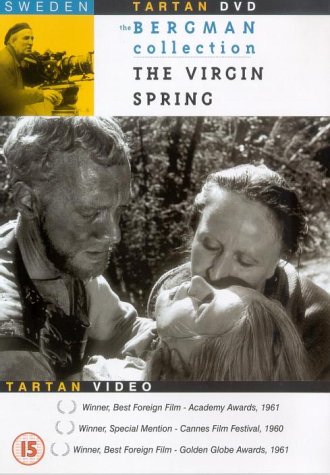The Virgin Spring review by Jackass Tom
I was first interested in the works of Ingmar Bergman when I heard about the movie Seventh Seal. Because of its U.S. availability it’s a pretty general starting spot for anyone looking to get into his work. There was nothing fancy about how he made his films. There were no trick shots, or effects ala Orson Welles. But there was an element of symbolism and style in his films that you couldn’t put your finger on the first time. And the story, was one that made you think more and more with each viewing. His characters were deep and full of thought and lived on past the credits (even in the afterlife). A few weeks I found myself in the library wanted to sink my teeth into another of Bergman’s works. Enter, The Virgin Spring a story just as thought provoking as The Seventh Seal and possibly more moving.
The Virgin Spring takes place in 14th century Sweden countryside. Tore (Max Von Sydow) and Mareta (Birgitta Valberg) are devout Christian’s who run a large farm. They prey often (in the morning, before every meal) and are very conscious about thanking the Lord for all his blessings. That includes their lovely virgin daughter Karin, who is sometimes a bit spoiled but still a good girl. Ingeri, one of the girls who works on the farm, represents all that is fallen and sinful. She is carrying a baby out of wedlock, prays to pagan Norse gods and wishes ill-will upon the more privileged Karin. The two girls are sent on a journey to church where the well dressed Karin will deliver a set of candles for a Holy Virgin holiday. Along the way, they get split up and Karin naively takes a break with three animal-like goat herders (two men, one boy). What follows is a savage rape and murder that is uncomfortable even under today’s numb standards. That same night, the goat herders seek refuge from the cold, unknowingly at the same farm where the two girls were from.
CAUTION SPOILER
What follows is the familiy’s brutal revenge on the herders which is nearly as uneasy to watch as the rape scene. This is Bergman’s gift to the story. He is able to show three men (well actually two men, with the little boy silently watching from a distant) do completely evil and despicable things to an innocent young girl. These three men have done the worst thing you can do to a woman, and he turns around and makes them the tragic victims 30 minutes later. The real blow comes when Tore takes his vengeance out on the poor defenseless boy. The boy really had nothing to do with the crime, but was guilty by association and paid for it with his life. The sin now lays on the hands of the devout Tore. He turns from revenge to redemption by professing to God that he will build a church where his daughter’s dead body still lays.
What a great film. Through two scenes of evil brutality, Bergman professes the evils of revenge (something our judicial system is based almost exclusively on) do nothing to cleanse one’s soul. Instead the true redemption comes from teaching, rehabilitation, and reaching out towards others instead of shutting them out. I’ll get off my soap box now.
END SPOILER
Bergman’s genius as a director also comes out through his use of symbols. All of his films seem to be filled with foreshadowing symbols, both obvious and hidden. Ingeri’s prayers for cursing Karin obviously set the tone for the whole movie. The farmhand’s comments about the little chicks being easily destroyed also reference how fragile life is in general. The frog that Ingeri plants in Karin’s bread signals the execution of her curse. In general, the black and white visuals are stunning and complement the dark theme of the film.
Horror fans may recognize the story. Apparently it was borrowed by Wes Craven for his directorial debut The Last House on the Left reviewed on this website by our very own horror connoisseur, Grim Ringler. Fans of Craven won’t find as much horror in this film as they will find suspenseful drama. There are elements of the supernatural (Ingeri’s forest encounter with an old man who recognized her paganism, and prognosticates the eventual doom of Karin hours before it happens), but this film serves a different genre. Apparently the film itself has roots in a Swedish fable (of which I have not read nor found any sort of link to on the Internet).
Virgin Spring is available on DVD but only outside of the U.S., as it is not as popular as Seventh Seal or Wild Strawberries. So if you want to see it in the States, you’ll have to do what I did, and rent a VHS. This movie is highly recommended to anyone who is a fan of high cinema and can stomach its content. It garnered Bergman his first Oscar for Foreign Language film in 1961 so it’s not only this jackass recommending it. Bergman is an extremely gifted director and story teller and holds nothing back in The Virgin Spring.








8 out of 10 Jackasses
